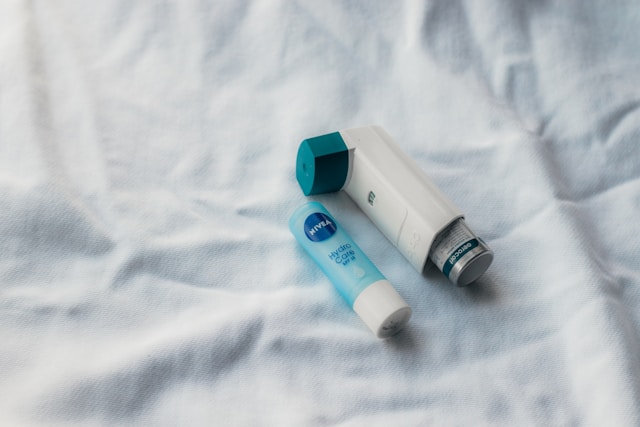
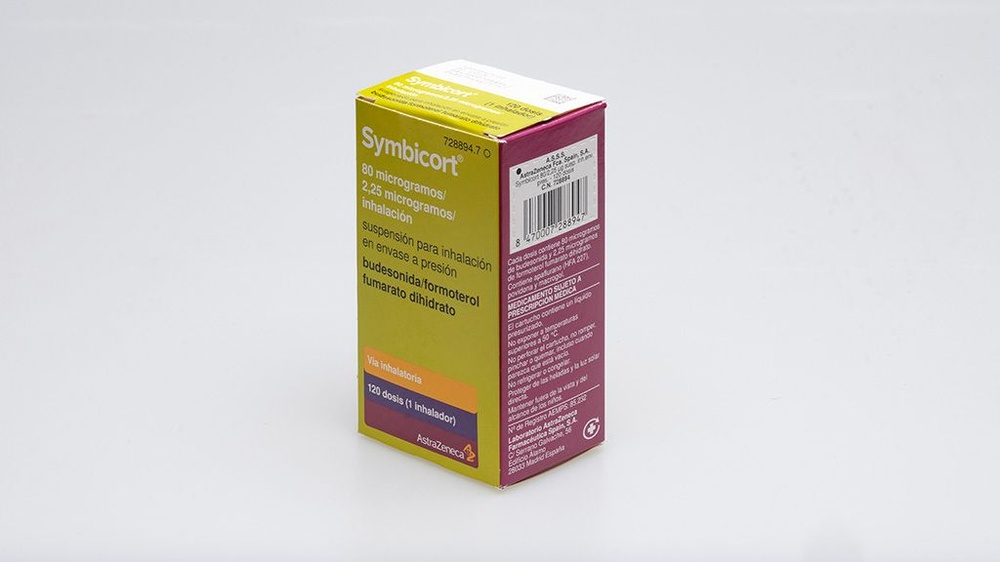
СИМБИКОРТ 80 мкг/2,25 мкг/ингаляция суспензия для ингаляций под давлением

Спросите врача о рецепте на СИМБИКОРТ 80 мкг/2,25 мкг/ингаляция суспензия для ингаляций под давлением

Инструкция по применению СИМБИКОРТ 80 мкг/2,25 мкг/ингаляция суспензия для ингаляций под давлением
Введение
Инструкция: информация для пользователя
Симбикорт 80микрограмм/2,25микрограмм/ингаляция суспензия для ингаляции в баллоне под давлением
Будесонид/формотерол фумарат дигидрат
Прочитайте внимательно всю инструкцию перед началом использования этого лекарства, поскольку она содержит важную информацию для вас.
- Сохраните эту инструкцию, поскольку вам может понадобиться прочитать ее снова.
- Если у вас есть какие-либо вопросы, проконсультируйтесь с вашим врачом или фармацевтом.
- Это лекарство было назначено только вам и не должно быть передано другим людям, даже если они имеют те же симптомы, что и вы, поскольку оно может нанести им вред.
- Если вы испытываете побочные эффекты, проконсультируйтесь с вашим врачом или фармацевтом, даже если это побочные эффекты, которые не указаны в этой инструкции. См. раздел 4.
Содержание инструкции
- Что такое Симбикорт и для чего он используется.
- Что вам нужно знать перед началом использования Симбикорта.
- Как использовать Симбикорт.
- Возможные побочные эффекты.
- Хранение Симбикорта.
- Содержание упаковки и дополнительная информация.
1. Что такое Симбикорт и для чего он используется
Что такое Симбикорт
Симбикорт - это ингалятор, используемый для лечения астмы у взрослых и подростков в возрасте от 12 до 17 лет. Он содержит два разных лекарства: будесонид и формотерол фумарат дигидрат.
- Будесонид относится к группе лекарств, называемых "кортикостероидами".
- Формотерол фумарат дигидрат относится к группе лекарств, называемых "бета2-адренергические агонисты длительного действия" или "бронходилататоры".
Для чего используется Симбикорт
Симбикорт используется для лечения астмы и может быть назначен только или с другим ингалятором "для облегчения симптомов" отдельно:
Некоторым пациентам назначают два ингалятора для астмы: ингалятор Симбикорт и другой ингалятор отдельно "для облегчения симптомов"
- Они используют Симбикорт ежедневно, что помогает предотвратить появление симптомов астмы.
- Они используют свой "ингалятор для облегчения симптомов" при появлении симптомов астмы, чтобы облегчить дыхание.
Некоторым пациентам назначают Симбикорт как единственный ингалятор для астмы
- Они используют Симбикорт ежедневно, что помогает предотвратить появление симптомов астмы.
- Они также используют Симбикорт при необходимости дополнительных доз для облегчения симптомов астмы, облегчая дыхание, и, если это согласовано с врачом, также для предотвращения появления симптомов астмы (например, при физических упражнениях или при воздействии других аллергенов). Им не нужен другой ингалятор отдельно для этой цели.
Как действует Симбикорт
- Будесонид действует, уменьшая и предотвращая воспаление легких.
- Формотерол фумарат дигидрат действует, расслабляя мышцы дыхательных путей, что помогает дышать более легко.
2. Что вам нужно знать перед началом использования Симбикорта
Не используйте Симбикорт:
- если вы аллергичны к будесониду, формотеролу или любому другому компоненту этого лекарства (перечисленному в разделе 6).
Предостережения и меры предосторожности
Проконсультируйтесь с вашим врачом или фармацевтом перед началом использования Симбикорта, если:
- У вас есть диабет.
- У вас есть инфекция легких.
- У вас есть высокое кровяное давление или вы когда-либо имели сердечное заболевание (включая нерегулярные сердечные сокращения, учащенное сердцебиение, сужение артерий или сердечную недостаточность).
- У вас есть проблемы с щитовидной железой или надпочечниками.
- У вас есть низкий уровень калия в крови.
- У вас есть тяжелые проблемы с печенью.
Проконсультируйтесь с вашим врачом, если у вас出现ится размытое зрение или другие нарушения зрения во время использования Симбикорта.
Дети
Не используйте это лекарство у детей младше 12 лет.
Использование в спорте
Это лекарство содержит формотерол, который может дать положительный результат при тестах на допинг.
Другие лекарства и Симбикорт
Сообщите вашему врачу или фармацевту, если вы используете, недавно использовали или можете использовать любое другое лекарство.
В частности, сообщите вашему врачу или фармацевту, если вы используете любое из следующих лекарств:
- Бета-блокаторы для высокого кровяного давления, такие как атенолол или пропранолол.
- Капли для глаз, такие как тимолол для глаукомы.
- Лекарства для лечения учащенного или нерегулярного сердцебиения, такие как хинидин.
- Лекарства, такие как дигоксин, обычно используемые для лечения сердечной недостаточности.
- Мочегонные средства для лечения высокого кровяного давления, такие как фуросемид.
- Гормональные лекарства, принимаемые внутрь, такие как преднизолон.
- Ксантиновые лекарства, такие как теофиллин или аминофиллин, обычно используемые для лечения астмы.
- Другие бронходилататоры, такие как салбутамол.
- Антидепрессанты, такие как амитриптилин и нефазодон.
- Фенотиазиновые лекарства, такие как хлорпромазин и прохлорперазин.
- Лекарства для лечения ВИЧ-инфекции, такие как ритонавир.
- Лекарства для лечения инфекций, такие как кетоконазол, итраконазол, вориконазол, позаконазол, кларитромицин и телитромицин.
- Лекарства для лечения болезни Паркинсона, такие как леводопа.
- Лекарства для лечения проблем с щитовидной железой, такие как левотироксин.
Если вы находитесь в любой из этих ситуаций или если вы не уверены, проконсультируйтесь с вашим врачом или фармацевтом перед использованием Симбикорта.
Также сообщите вашему врачу или фармацевту, если вы собираетесь пройти общую анестезию для хирургической операции или стоматологического лечения.
Беременность и лактация
- Сообщите вашему врачу перед использованием этого лекарства, если вы беременны или планируете стать беременной; проконсультируйтесь с вашим врачом перед использованием Симбикорта - не используйте Симбикорт, если только ваш врач не назначит его.
- Если вы становитесь беременной во время лечения Симбикортом, не прекращайте его использование и проконсультируйтесь с вашим врачом немедленно.
- Если вы кормите грудью, проконсультируйтесь с вашим врачом перед использованием Симбикорта.
Вождение и использование машин
Влияние Симбикорта на способность управлять транспортными средствами и работать с машинами является незначительным или отсутствует.
3. Как использовать Сымбикорт
Следуйте точно инструкциям по применению этого лекарства, указанным вашим врачом или фармацевтом. В случае сомнений проконсультируйтесь снова с вашим врачом или фармацевтом.
- Важно использовать Сымбикорт ежедневно, даже если в этот момент у вас нет признаков астмы.
- Ваш врач будет регулярно проверять, как протекают ваши симптомы астмы.
- Ваш врач может рассмотреть возможность добавления к вашему обычному лечению таблеток стероидов в периоды стресса (например, когда у вас инфекция в грудной клетке или перед операцией).
Сымбикорт может быть назначен для астмы самостоятельно или с другим ингалятором для облегчения симптомов отдельно. Вам необходимо сделать два вдоха Сымбикорта, чтобы получить полную дозу. Количество Сымбикорта, которое вам необходимо использовать, и когда его необходимо использовать, будет зависеть от того, что вам назначил врач.
- Если вам назначен Сымбикорт и ингалятор для облегчения симптомов отдельно, прочитайте раздел «а) Использование Сымбикорта и другого ингалятора отдельно для облегчения симптомов».
- Если вам назначен Сымбикорт как единственный ингалятор, прочитайте раздел «б) Использование Сымбикорта как единственного ингалятора для астмы».
- Использование Сымбикорта и другого ингалятора отдельно для облегчения симптомов
Используйте Сымбикорт ежедневно. Это помогает предотвратить появление признаков астмы.
Взрослые (старше 18 лет)
- Обычная доза составляет 2-4 вдоха, дважды в день.
- Ваш врач может назначить вам до максимальной дозы 8 вдохов, дважды в день.
- Если ваши симптомы астмы хорошо контролируются, ваш врач может попросить вас использовать лекарство один раз в день.
Подростки (от 12 до 17 лет)
- Обычная доза составляет 2-4 вдоха, дважды в день.
- Если ваши симптомы астмы хорошо контролируются, ваш врач может попросить вас использовать лекарство один раз в день.
Ваш врач (или медсестра) поможет вам контролировать астму. Они отрегулируют дозу этого лекарства до минимальной дозы, которая контролирует вашу астму. Однако не изменяйте и не прекращайте дозу без предварительной консультации с вашим врачом (или медсестрой).
Используйте свой другой «ингалятор для облегчения симптомов», когда появляются симптомы астмы.
- Всегда носите с собой этот «ингалятор для облегчения симптомов», чтобы использовать его, когда это необходимо.
- Не используйте Сымбикорт для лечения симптомов астмы, а используйте ингалятор для облегчения симптомов.
- Использование Сымбикорта как единственного ингалятора для астмы
Используйте Сымбикорт только в том случае, если ваш врач назначил его и если вам больше 12 лет.
Используйте Сымбикорт ежедневно. Это помогает предотвратить появление симптомов астмы. Вы можете:
- делать 2 вдоха утром и 2 вдоха вечером;
- делать 4 вдоха утром;
- делать 4 вдоха вечером.
Ваш врач может увеличить дозу до 4 вдохов, дважды в день.
Используйте также Сымбикорт как «ингалятор для облегчения симптомов» для лечения симптомов астмы, когда они появляются, и для предотвращения появления симптомов астмы (например, при физических упражнениях или при воздействии аллергенов).
- Если у вас появляются симптомы астмы, сделайте 2 вдоха и подождите несколько минут.
- Если вы не чувствуете себя лучше, сделайте еще 2 вдоха.
- Не делайте более 12 вдохов за один раз.
Всегда носите с собой ингалятор Сымбикорта, чтобы использовать его, когда это необходимо.
Обычно не требуется суточная доза более 16 вдохов. Однако ваш врач может разрешить вам делать до 24 вдохов в день в течение ограниченного периода.
Если вам обычно необходимо использовать 16 или более вдохов в день, обратитесь к вашему врачу или медсестре, поскольку вам может потребоваться изменить лечение.
Не делайте более 24 вдохов в течение 24 часов.
Если вы занимаетесь физическими упражнениями и замечаете симптомы астмы, используйте Сымбикорт, как описано здесь. Важно, чтобы вы проконсультировались с вашим врачом о использовании Сымбикорта для предотвращения появления симптомов астмы; как частота занятий физическими упражнениями, так и частота воздействия аллергенов могут повлиять на назначенное лечение.
Сымбикорт и таблетки стероидов
Если вы принимали таблетки стероидов для астмы, ваш врач может уменьшить количество таблеток, которые вы принимаете, после того, как вы начнете лечение Сымбикортом. Если вы принимали таблетки стероидов в течение длительного времени, ваш врач может захотеть сделать анализ крови время от времени. Когда вам уменьшат количество таблеток стероидов, вы можете чувствовать общее недомогание, даже если ваши легочные симптомы улучшаются. Симптомы могут быть:
- насморк или выделения из носа
- слабость
- боль в суставах или мышцах
- кожная сыпь (уртикария).
Обратитесь к вашему врачу немедленно, если у вас появляются симптомы, такие как:
- головная боль
- усталость
- тошнота
- рвота.
Если у вас появляются какие-либо из вышеперечисленных симптомов, обратитесь к вашему врачу немедленно; возможно, вам придется принимать другое лекарство. Обсудите с вашим врачом, если вы обеспокоены тем, следует ли продолжать использовать Сымбикорт.
Использование у детей
Существуют другие формы этого лекарства, подходящие для детей; проконсультируйтесь с вашим врачом или фармацевтом.
Важная информация о ваших симптомах астмы
Если во время использования Сымбикорта вы чувствуете затруднение дыхания или издаете свистящие звуки при дыхании, продолжайте использовать его и свяжитесь с вашим врачом как можно скорее, поскольку вам может потребоваться дополнительное лечение.
Обратитесь к вашему врачу немедленно, если:
- ваша дыхательная функция ухудшается или вы часто просыпаетесь ночью с симптомами астмы;
- вы начинаете чувствовать сдавление в груди утром или сдавление в груди длится дольше, чем обычно;
- эти признаки могут указывать на то, что ваша астма не контролируется должным образом, и вам может потребоваться немедленное другое или дополнительное лечение.
Информация о вашем новом ингаляторе Сымбикорт
 Прежде чем использовать ваш новый ингалятор Сымбикорт, выньте его из алюминиевой упаковки. Выбросьте упаковку, а также высушивающий агент, находящийся внутри упаковки. Не используйте ингалятор, если высушивающий агент выпал из упаковки.
Прежде чем использовать ваш новый ингалятор Сымбикорт, выньте его из алюминиевой упаковки. Выбросьте упаковку, а также высушивающий агент, находящийся внутри упаковки. Не используйте ингалятор, если высушивающий агент выпал из упаковки.- Ингалятор должен использоваться в течение 3 месяцев после того, как его вынули из алюминиевой упаковки. Запишите на этикетке ингалятора дату окончания срока использования (3 месяца после вскрытия упаковки), чтобы напомнить вам, когда необходимо прекратить использование ингалятора.
- На изображении показаны части, из которых состоит ингалятор, который уже будет собран, когда его вам дадут. Если контейнер ослабнет, верните его в ингалятор и продолжайте использовать.
Подготовка Сымбикорта
Необходимо подготовить ингалятор к использованию в следующих ситуациях:
- если вы используете новый Сымбикорт впервые;
- если вы не использовали его более 7 дней;
- если он упал.
Чтобы подготовить ингалятор к использованию, следуйте следующим инструкциям:
- Встряхните ингалятор в течение как минимум 5 секунд, чтобы смешать содержимое аэрозольного картриджа.
- Удалите крышку с части для рта, слегка нажав на выступы на боковой части. Крышка останется прикрепленной к ингалятору.
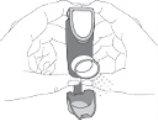
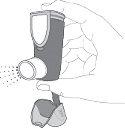 Держите ингалятор в вертикальном положении. Затем нажмите на счетчик (в верхней части ингалятора), чтобы выпустить распыление в воздух. Вы можете использовать одну или обе руки, как показано на фотографиях.
Держите ингалятор в вертикальном положении. Затем нажмите на счетчик (в верхней части ингалятора), чтобы выпустить распыление в воздух. Вы можете использовать одну или обе руки, как показано на фотографиях.- Удалите палец (пальцы) со счетчика.
- Подождите 10 секунд, хорошо встряхните и повторите шаги 3 и 4.
- Ваш ингалятор теперь готов к использованию.
Как сделать вдох
Каждый раз, когда вам необходимо сделать вдох, следуйте этим инструкциям:
- Встряхните ингалятор в течение как минимум 5 секунд, чтобы смешать содержимое аэрозольного картриджа.
- Удалите крышку с части для рта, слегка нажав на выступы на боковой части. Проверьте, что часть для рта не заблокирована.
 Держите ингалятор в вертикальном положении (вы можете использовать одну руку или обе). Медленно выдохните воздух.
Держите ингалятор в вертикальном положении (вы можете использовать одну руку или обе). Медленно выдохните воздух.- Аккуратно поместите часть для рта между зубами. Закройте губы.
- Вдохните медленно и глубоко через рот. Нажмите крепко на счетчик (в верхней части ингалятора), чтобы выпустить распыление. Держите воздух на мгновение, пока нажимаете на счетчик. Вдохните одновременно с нажатием на счетчик, чтобы обеспечить попадание лекарства в легкие.
- Держите дыхание в течение 10 секунд или максимально комфортного времени.
- Прежде чем выдохнуть воздух, отпустите палец со счетчика и удалите ингалятор изо рта. Держите ингалятор в вертикальном положении.
- Медленно выдохните воздух. Прежде чем сделать еще один вдох, хорошо встряхните ингалятор в течение как минимум 5 секунд и повторите шаги с 3 по 7.
- Закройте снова крышку части для рта.
- Прополощите рот водой после утренних и вечерних доз Сымбикорта. Не глотайте.
Использование камеры-расширителя
Ваш врач, медсестра или фармацевт могут предложить вам использовать камеру-расширитель (например, Aerochamber Plus Flow Vu или Aerochamber Plus). Следуйте инструкциям, указанным в инструкции, прилагаемой к камере-расширителю.
Очистка Сымбикорта
- Очистите внутреннюю и внешнюю части для рта как минимум один раз в неделю сухой тканью.
- Не используйте воду или жидкости.
- Не отделяйте картридж от ингалятора.
Как узнать, когда необходимо заменить ингалятор Сымбикорт?
- Счетчик в верхней части ингалятора показывает, сколько вдохов осталось в вашем ингаляторе Сымбикорт. Он начинается с 60 или 120 вдохов, когда он полный.
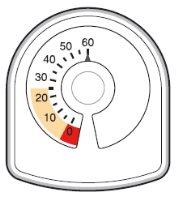
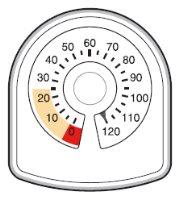
- Каждый раз, когда вы делаете вдох или выпускаете его в воздух, стрелка начинает обратный отсчет до нуля («0»).
- Когда стрелка впервые входит в желтую зону, это означает, что осталось около 20 вдохов.
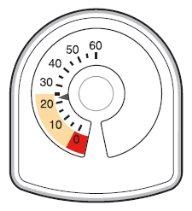
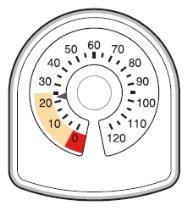
- Когда стрелка достигает «0», необходимо прекратить использование ингалятора Сымбикорт. Возможно, вам не покажется, что ингалятор пуст, и он, кажется, все еще работает, но вы не получите правильное количество лекарства, если продолжите использовать его.
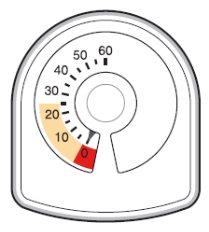
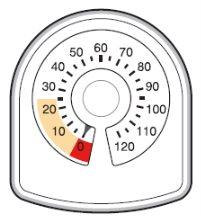
Если вы использовали больше Сымбикорта, чем необходимо
Важно вдыхать вашу дозу, как указано на этикетке фармацевта или как рекомендовал ваш врач. Не используйте больше доз, чем назначено, без консультации с вашим врачом.
Если вы использовали больше Сымбикорта, чем необходимо, проконсультируйтесь с вашим врачом или фармацевтом. Симптомы и признаки, которые могут возникнуть после передозировки, являются тряска, головная боль и быстрое сердцебиение.
В случае передозировки или случайного приема обратитесь в Центр токсикологической информации. Телефон: 91 5620420, указав лекарство и количество, принятое внутрь.
Если вы забыли использовать Сымбикорт
- Если вы забыли какую-либо из доз Сымбикорта, продолжайте лечение, рекомендованное вашим врачом, как можно скорее. Однако, если это почти время вашей следующей дозы, не беспокойтесь о пропущенной дозе.
- Неиспользуйте двойную дозу, чтобы компенсировать пропущенные дозы.
Если вы прекратили лечение Сымбикортом
Прежде чем прекратить использование Сымбикорта, необходимо проконсультироваться с врачом или фармацевтом. Если вы прекратите использование Сымбикорта, симптомы астмы могут ухудшиться.
Если у вас есть другие вопросы об использовании этого лекарства, обратитесь к вашему врачу или фармацевту.
4. Возможные побочные эффекты
Как и все лекарства, это лекарство может вызывать побочные эффекты, хотя не все люди испытывают их.
Если у вас возникает один из следующих симптомов, прекратите использовать Сымбикорт и немедленно обратитесь к вашему врачу:
- У вас опухает лицо, особенно вокруг рта (языка и/или горла и/или трудности с глотанием) или появляется крапивница вместе с трудностями дыхания (ангиоэдем) и/или вы чувствуете внезапное чувство слабости, что указывает на то, что вы можете испытывать аллергическую реакцию. Это происходит редко, затрагивая менее 1 из 1000 пациентов.
- У вас появляются свистящие звуки или трудности дыхания сразу после использования ингалятора Сымбикорт. Если у вас возникнут эти симптомы, немедленно прекратите использовать Сымбикорт и используйте свой отдельный «ингалятор для облегчения симптомов», если он у вас есть. Обратитесь к вашему врачу немедленно, поскольку вам может потребоваться изменить лечение.Это происходит очень редко, затрагивая менее 1 из 10 000 пациентов.
Другие возможные побочные эффекты:
Частые (могут затронуть до 1 из 10 пациентов)
- Сердцебиение (чувство сердечных сокращений), тряска или озноб. Эти эффекты, если они появляются, обычно легкие и исчезают, когда вы начинаете использовать Сымбикорт.
- Молочница (грибковая инфекция) во рту; этот эффект менее вероятен, если вы прополощете рот водой после утренних и вечерних доз Сымбикорта.
- Легкая раздражение горла, кашель, хрипота.
- Головная боль.
Редкие (могут затронуть до 1 из 100 пациентов)
- Тревога, беспокойство, нервозность.
- Трудности со сном.
- Головокружение.
- Тошнота (неприятное ощущение).
- Ускоренное сердцебиение.
- Синяки на коже.
- Мышечные спазмы.
- Размытое зрение.
Очень редкие (могут затронуть до 1 из 1000 пациентов)
- Сыпь, зуд.
- Бронхоспазм (сужение мышц дыхательных путей, что приводит к свистящим звукам). Если у вас появляются свистящие звуки сразу после использования Сымбикорта, прекратите использовать его и обратитесь к вашему врачу немедленно.
- Низкие уровни калия в крови.
- Нерегулярное сердцебиение.
Очень редкие (могут затронуть до 1 из 10 000 пациентов)
- Депрессия.
- Изменения поведения, особенно у детей.
- Боль или сдавление в груди (стенокардия).
- Увеличение уровня сахара (глюкозы) в крови.
- Нарушения вкуса, такие как неприятный вкус во рту.
- Изменения артериального давления.
Ингаляционные кортикостероиды могут влиять на нормальное производство стероидных гормонов в организме, особенно если используются высокие дозы в течение длительного времени. Эти эффекты включают:
- изменения плотности костей (истончение костей)
- катаракта (потеря прозрачности хрусталика в глазу)
- глаукома (повышение внутриглазного давления)
- замедление роста у детей и подростков
- влияние на надпочечные железы (маленькие железы, расположенные рядом с почками).
Эти эффекты намного менее вероятны с ингаляционными кортикостероидами, чем с таблетками кортикостероидов.
Сообщение о побочных эффектах
Если вы испытываете любой побочный эффект, обратитесь к вашему врачу или фармацевту, даже если это побочные эффекты, которые не перечислены в этом листке инструкции. Вы также можете сообщить об этом напрямую через Испанскую систему фармаковигиланса для лекарств для человека: www.notificaRAM.es.
Сообщая о побочных эффектах, вы можете внести свой вклад в предоставление более полной информации о безопасности этого лекарства.
5. Хранение Сымбикорта
- Храните это лекарство вне поля зрения и досягаемости детей.
- Не используйте это лекарство после даты истечения срока годности, указанной на картонной упаковке, алюминиевой упаковке или этикетке картриджа после «CAD». Дата истечения срока годности — последний день месяца, указанного.
- Лекарство должно использоваться в течение 3 месяцев после того, как ингалятор был удален из алюминиевой упаковки. Запишите дату истечения срока годности (3 месяца после вскрытия упаковки) на этикетке ингалятора, чтобы напомнить вам, когда необходимо прекратить использование ингалятора.
- Как и в случае с большинством ингаляционных лекарств в аэрозольных упаковках, эффект этого лекарства может уменьшиться, когда упаковка холодная. Для достижения лучших результатов это лекарство должно быть при комнатной температуре перед использованием.
- Не храните в холодильнике или не замораживайте. Защитите от мороза и прямого солнечного света.
- Всегда возвращайте крышку части для рта и закрепляйте ее на месте после использования ингалятора.
- Лекарства не должны выбрасываться в канализацию или мусор. Поместите упаковки и лекарства, которые вам больше не нужны, в пункт SIGRE аптеки. Спросите вашего фармацевта, как избавиться от упаковок и лекарств, которые вам больше не нужны. Таким образом, вы поможете защитить окружающую среду.
Предупреждение: Картридж содержит сжатую жидкость. Не подвергайте воздействию температур выше 50°C. Не прокалывайте картридж. Картридж не должен быть разорван, проколот или сожжен, даже если он кажется пустым.
6. Содержимое упаковки и дополнительная информация
Состав Симвикорта
Активные вещества - будесонид и формотерол фумарат дигидрат. Каждая доза для ингаляции содержит 80 микрограммов будесонида и 2,25 микрограмма формотерола фумарата дигидрата.
Другие вспомогательные вещества - апафлуран (HFA 227), повидон и макрогол. Этот ингалятор не содержит ХФУ.
Этот препарат содержит фторированные газы, способствующие парниковому эффекту. Каждый ингалятор содержит 10,8 г апафлурана (HFC-227ea), что соответствует 0,035 тоннам CO2-эквивалента (потенциал глобального потепления ПГП = 3220).
Внешний вид продукта и содержимое упаковки
Симвикорт - это ингалятор, содержащий лекарственное средство. Лекарственное средство, суспензия для ингаляции белого цвета, представлено в картридже под давлением с индикатором дозировки. Картридж установлен в пластиковом адаптере красного цвета с пластиковой белой насадкой и интегрированной пластиковой крышкой серого цвета. Каждый ингалятор содержит 60 или 120 ингаляций после подготовки к использованию. Каждый ингалятор упакован индивидуально в алюминиевую обертку, содержащую десикант.
Симвикорт 80 микрограммов/2,25 микрограмма/ингаляция суспензия для ингаляции в упаковке под давлением (будесонид/формотерол фумарат дигидрат) доступен в упаковках с одним ингалятором.
Возможно, будут продаваться только некоторые размеры упаковок.
Владелец разрешения на маркетинг и ответственный за производство
Владелец:
Лаборатория АстраЗенека Фармацевтика Испания, С.А.
К/ Пуэрто де Сомпорт 21-23
28050 Мадрид
Испания
Ответственный за производство:
АстраЗенека Дюнкерк Производство
224, Авеню де ла Дордонь БП 41
59640 Дюнкерк (Франция)
Этот препарат разрешен в государствах-членах Европейского экономического пространства под следующими названиями:
Австрия: Симвикорт 80 микрограмм/2,25 микрограмма/ингаляция, ингалятор под давлением, суспензия; Бельгия: Симвикорт 80 микрограмм/2,25 микрограмма/ингаляция, аэрозоль, суспензия; Симвикорт 80 микрограммов/2,25 микрограмма/ингаляция, суспензия для ингаляции в упаковке под давлением; Симвикорт 80 микрограмм/2,25 микрограмма/ингаляция, ингалятор под давлением, суспензия; Болгария: Симвикорт 80 микрограма/2,25 микрограма/ингаляция, ингалятор под давлением, суспензия; Кипр: Симвикорт 80 микрограмм/2,25 микрограмма/ингаляция; Хорватия: Симвикорт 80 микрограмм/2,25 микрограмма/ингаляция, ингалятор под давлением, суспензия; Дания: Симвикорт 80 микрограмм/2,25 микрограмма/ингаляция; Словакия: Симвикорт 80 микрограммов/2,25 микрограмма/ингаляционная доза, ингаляционная суспензия в упаковке под давлением; Словения: Симвикорт 80 микрограммов/2,25 микрограмма/ингаляция, ингаляционная суспензия под давлением; Испания: Симвикорт 80 микрограммов/2,25 микрограмма/ингаляция суспензия для ингаляции в упаковке под давлением; Эстония: Симвикорт; Финляндия: Симвикорт 80 микрограмм/2,25 микрограмма/ингаляция; Франция: Симвикорт 100/3 микрограмма/ингаляция, суспензия для ингаляции в упаковке под давлением; Греция: Симвикорт 80 микрограмм/2,25 микрограмма/ингаляция; Нидерланды: Симвикорт аэрозоль 100/3, 100 микрограмм/3 микрограмма на дозу, аэрозоль, суспензия; Венгрия: Симвикорт 2,25 микрограмма/80 микрограмм/доза, ингалятор под давлением, суспензия; Исландия: Симвикорт 80 микрограмм/2,25 микрограмма/ингаляция; Италия: Симвикорт; Латвия: Симвикорт 80 микрограммов/2,25 микрограмма/ингаляция, ингаляционная суспензия под давлением; Литва: Симвикорт 80 микрограммов/2,25 микрограмма/ингаляция, ингаляционная суспензия под давлением; Люксембург: Симвикорт 80 микрограммов/2,25 микрограмма/ингаляция, суспензия для ингаляции в упаковке под давлением; Мальта: Симвикорт 100 микрограммов/3 микрограмма/ингаляция, ингалятор под давлением, суспензия; Норвегия: Симвикорт 80 микрограмм/2,25 микрограмма/ингаляция; Польша: Симвикорт; Португалия: Симвикорт 80 микрограммов/2,25 микрограмма/ингаляция суспензия для ингаляции в упаковке под давлением; Великобритания: Симвикорт 100 микрограммов/3 микрограмма на актуацию, ингалятор под давлением, суспензия; Чехия: Симвикорт 80 микрограммов/2,25 микрограмма/ингаляция, суспензия в пМДИ; Румыния: Симвикорт 80 микрограммов/2,25 микрограмма/ингаляция, суспензия для ингаляции под давлением; Швеция: Симвикорт 80 микрограмм/2,25 микрограмма/ингаляция
Дата последнего пересмотра этой инструкции: Январь 2025
Подробная и актуальная информация о этом препарате доступна на сайте Испанского агентства по лекарственным средствам и медицинским изделиям (АЕМПС) http://www.aemps.gob.es/

Сколько стоит СИМБИКОРТ 80 мкг/2,25 мкг/ингаляция суспензия для ингаляций под давлением в Испании в 2025 году?
Средняя цена на СИМБИКОРТ 80 мкг/2,25 мкг/ингаляция суспензия для ингаляций под давлением в ноябрь, 2025 года составляет около 19.78 евро. Финальная стоимость может зависеть от региона, конкретной аптеки и рецептурного статуса. Для точной информации лучше проверить онлайн или в ближайшей аптеке.
- Страна регистрации
- Средняя цена в аптеках19.78 EUR
- Активное вещество
- Требуется рецептДа
- Производитель
- Информация носит справочный характер и не является медицинской рекомендацией. Перед приемом любых препаратов проконсультируйтесь с врачом. Oladoctor не несет ответственности за медицинские решения, принятые на основе этого контента.
- Аналоги СИМБИКОРТ 80 мкг/2,25 мкг/ингаляция суспензия для ингаляций под давлениемФорма выпуска: ИНГАЛЯЦИЯ ЛЕГОЧНАЯ, 160 микрограмм / 4,5 микрограммаАктивное вещество: formoterol and budesonideПроизводитель: Teva Pharma B.V.Требуется рецептФорма выпуска: ИНГАЛЯЦИЯ ЛЕГОЧНАЯ, 320 микрограмм / 9 микрограммАктивное вещество: formoterol and budesonideПроизводитель: Teva Pharma B.V.Требуется рецептФорма выпуска: ИНГАЛЯЦИЯ ЛЕГОЧНАЯ, 160 МИКРОГРАММ/4,5 МИКРОГРАММААктивное вещество: formoterol and budesonideПроизводитель: Cipla Europe N.V.Требуется рецепт
Аналоги СИМБИКОРТ 80 мкг/2,25 мкг/ингаляция суспензия для ингаляций под давлением в других странах
Лучшие аналоги с тем же действующим веществом и терапевтическим эффектом.
Аналог СИМБИКОРТ 80 мкг/2,25 мкг/ингаляция суспензия для ингаляций под давлением в Poland
Аналог СИМБИКОРТ 80 мкг/2,25 мкг/ингаляция суспензия для ингаляций под давлением в Ukraine
Врачи онлайн по СИМБИКОРТ 80 мкг/2,25 мкг/ингаляция суспензия для ингаляций под давлением
Консультация по дозировке, побочным эффектам, взаимодействиям, противопоказаниям и продлению рецепта на СИМБИКОРТ 80 мкг/2,25 мкг/ингаляция суспензия для ингаляций под давлением – по решению врача и с учетом местных правил.




